
Photo from wikipedia
OBJECTIVES To analyze clinical factors associated with operator's preference in selection of femoral versus radial access for angiography and percutaneous intervention (PCI) procedures. BACKGROUND There has been an increase in… Click to show full abstract
OBJECTIVES To analyze clinical factors associated with operator's preference in selection of femoral versus radial access for angiography and percutaneous intervention (PCI) procedures. BACKGROUND There has been an increase in radial access in cardiac catheterization and PCI in the last few decades. METHODS Data from 11 226 consecutive cardiac catheterization procedures were collected from Sanford University Medical Center (University of South Dakota, Sanford School of Medicine) from 2011 to 2015. RESULTS In the overall cases, clinical factors that favored upfront femoral access include patients presenting as ST-elevation myocardial infarction (STEMI) or emergent, coronary artery bypass graft, body mass index (BMI) <30 kg/m2 and age ≥70 years, whereas morbidly obese patients (BMI ≥35) and age <70 favored upfront radial access. Radial access in the overall group had lower fluoroscopy time (6.5 vs 8.4 min, P < 0.0001) and lower contrast use (68.8 vs 80.6 cc, P < 0.0001). In the PCI group, efficacy of upfront radial access is less evident with radial fluoroscopy time (10.1 vs 11.0 min, P < 0.0028) and contrast use being higher in radial group (113.8 vs 108.2 cc, P < 0.037). Interventional cardiologists were more efficient in diagnostic cases than non-interventional cardiologists. CONCLUSION STEMI or emergent cases and elderly patients favor upfront femoral access. As BMI increases and age decreases, radial access is progressively favored. In diagnostic cases, radial access appears to be superior to femoral access in efficacy, but the distinction is less obvious in PCI and STEMI or emergent cases.
Journal Title: Journal of Interventional Cardiology
Year Published: 2018
Link to full text (if available)
Share on Social Media: Sign Up to like & get
recommendations!